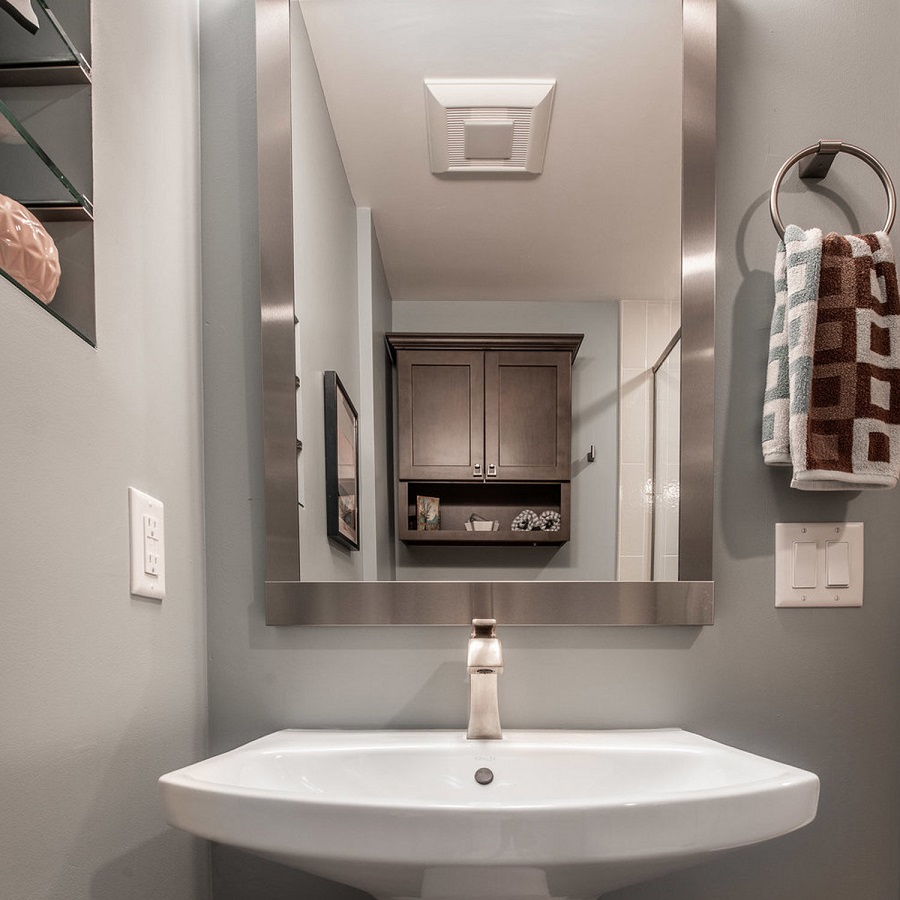Introduction to Bathroom Exhaust Fans
When it comes to enhancing your bathroom, the ventilation system might not be the first thing that comes to mind. Yet, installing a quality bathroom exhaust fan is essential for maintaining a comfortable and healthy bathroom environment. These fans effectively expel moisture and odors from your bathroom, ensuring that it remains dry and clean.
The primary function of a bathroom exhaust fan is to remove stale, humid air and replace it with fresh air from outside. This process helps to prevent the buildup of mold, mildew and dampness which can lead to health problems and damage your bathroom’s surfaces and fixtures. A well-ventilated bathroom also prevents the peeling of wallpaper and paint due to excessive moisture.
Bathroom fan installation may seem daunting, but with the right information and tools, it can be a straightforward task. In this blog, we’ll guide you through the key points to consider before installing an exhaust fan, different types of fans and where to install them, and the innovative features that can enhance your bathroom’s ventilation.
We’ll also provide a step-by-step guide to help you through the installation process, discuss common mistakes and how to avoid them, and explain how to determine the correct fan size and CFM (Cubic Feet per Minute) rating for your bathroom. When it’s time to replace an existing fan, we’ll go over the signs that your fan may no longer be effective. Let’s dive into the world of bathroom exhaust fans and improve your bathroom experience.

Importance and Benefits of Exhaust Fan Installation
Installing a bathroom exhaust fan has many benefits. It helps keep your bathroom fresh and dry. With less moisture, you cut down on mold and mildew growth. This also prevents wallpaper and paint from peeling. A fan can banish bad odors quickly. It also gets rid of excess heat in the bathroom, making it more comfortable. Overall, a fan makes your bathroom pleasant for everyone. Remember, these fans are not just for comfort. They protect your health by reducing humidity. This can stop harmful molds from affecting your air quality. Fans also keep fixtures and surfaces in better shape for longer. Think about these factors when you plan a bathroom fan installation.
Fan Types and Installation Places
Choosing the right type of bathroom exhaust fan and its installation location is critical. You will usually find two main types: ceiling-mounted and wall-mounted fans.
Ceiling-Mounted Fans
Ceiling-mounted fans are popular and powerful. They go on your bathroom ceiling, usually near the shower or tub. This type takes the humid air up and out through the roof or an external wall.
Wall-Mounted Fans
Wall-mounted fans, however, install on an exterior wall. They push air directly outside. This type can be easier to install since they often don’t need ducting.
Selecting where to place your fan is also key. It should be between the toilet and shower for best air movement. Make sure not to install directly over a heat source or window. Also, think about existing wires or pipes in the installation spot.
For homes without fans, installing in the right spot can be tricky. You may need the help of a professional to find the best location.
No matter which type or where you place it, the goal is to move moist air out efficiently. A well-placed fan keeps your bathroom dry and comfy. Remember, proper fan installation also means less mold risk and a cleaner-smelling bathroom.
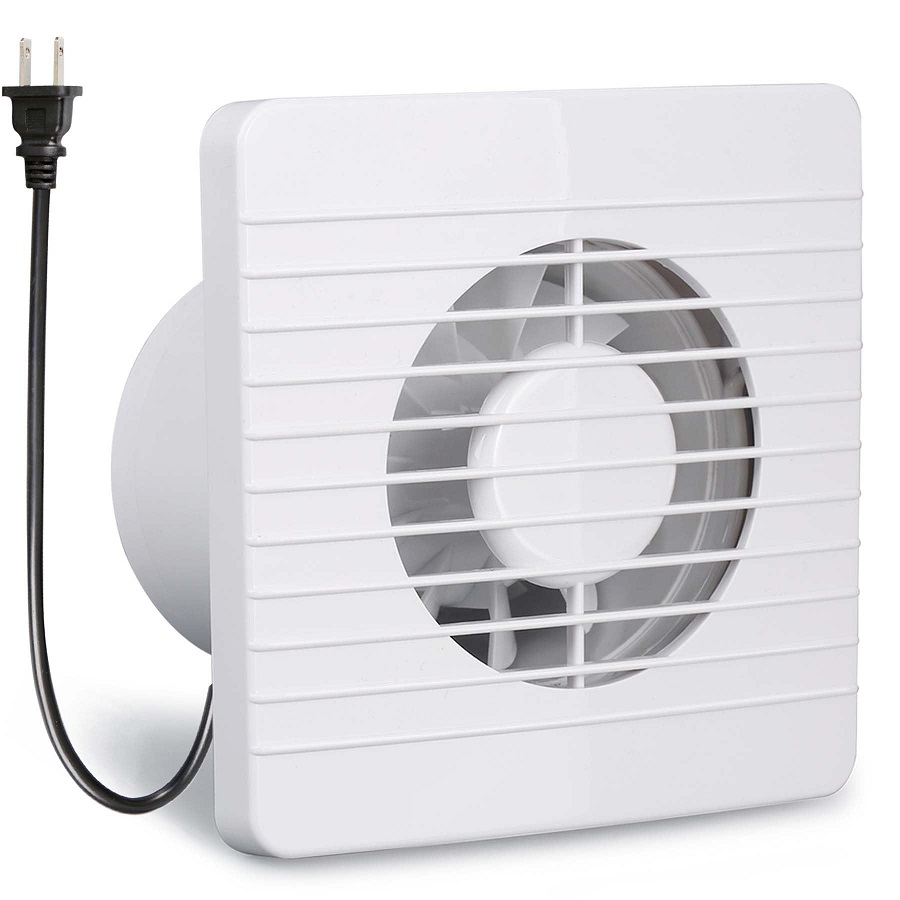
Fan Features and Innovations
Today’s market offers bathroom exhaust fans with features that go beyond basic ventilation. Innovations now focus on user comfort, energy efficiency, and ease of use. Here’s what to look out for:
Built-in Lights
Some fans come with integrated lighting. This feature reduces the need for additional light fixtures and simplifies installation.
Humidity Sensors
Humidity-sensing fans turn on automatically when moisture levels rise. This keeps humidity under control without manual intervention.
Motion Sensors
Fans with motion sensors activate when someone enters the bathroom. This ensures the fan only runs when necessary, saving energy.
Timers
Timers let you set how long the fan runs. This helps prevent over-ventilation and conserves electricity after you leave the bathroom.
Heaters
Select fans include built-in heaters. A fan with a heater provides warmth, making your bathroom more comfortable in cold weather.
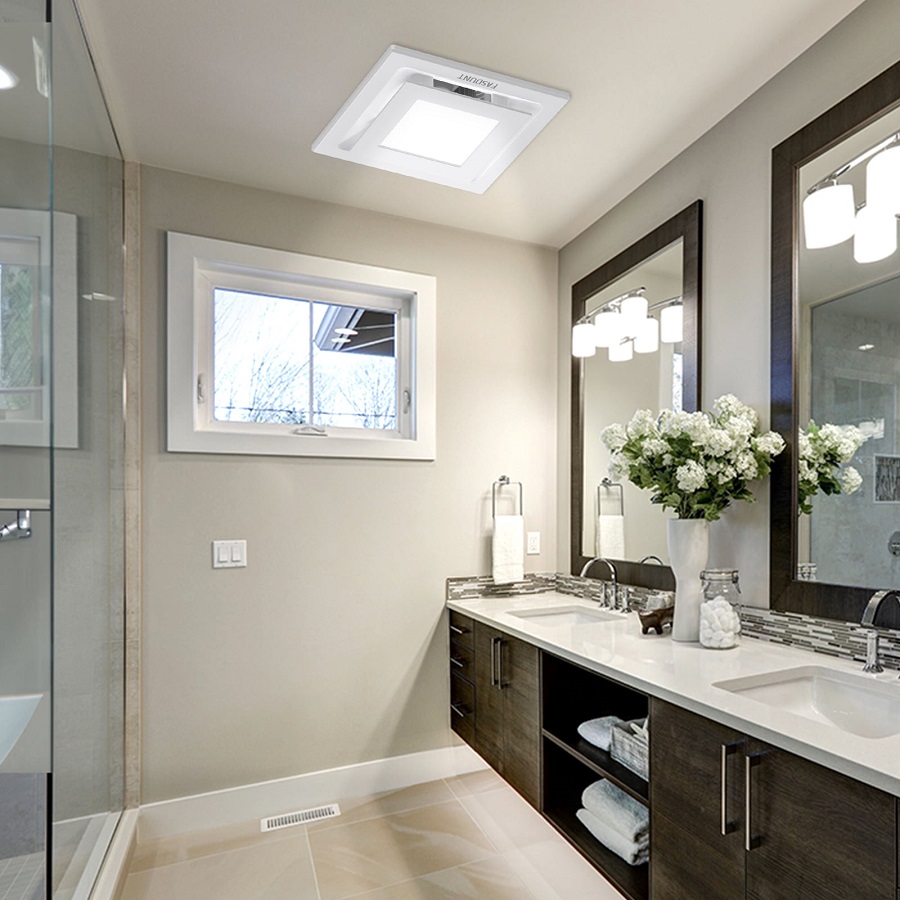
Noise Level Controls
Modern fans offer quieter operation. Look for low-sone ratings when you seek a peaceful bathroom environment.
Smart Features
Smart fans can connect to home automation systems. They allow for remote control and scheduling through smart devices.
Energy Efficiency
Energy Star rated fans use less power. This leads to lower electricity bills and less environmental impact.
When picking a fan, consider these features based on your needs. Enhanced features might increase costs, but they add convenience and comfort to your bathroom experience.
Installing a Bathroom Exhaust Fan
Installing a bathroom exhaust fan can seem complex, but by following these clear steps, the process can become quite manageable, even for those with limited DIY experience. Here’s a simple guide to help you through the installation:
- Choose the Right Location: Place the fan between the toilet and shower where air movement is optimal. Avoid heat sources and windows.
- Turn Off Electricity: Before you start, ensure the power is switched off to prevent any electrical hazards.
- Mark the Ceiling or Wall: Use the fan’s housing as a guide to mark where you’ll cut. Check for joists, cables, or wires first.
- Cut Out the Opening: Wearing safety glasses, cut along the marked outline with a drywall saw or jigsaw.
- Secure the Fan: Mount the fan onto the ceiling joists or wall studs using screws, ensuring it’s firmly in place.
- Connect Ducting: Attach a duct to channel air outside. Use duct tape or clamps for a secure fit.
- Ensure Proper Venting: The duct must vent to the outside, not into an attic or crawl space.
- Wire the Fan: Connect the fan to the electrical power, matching wire colors. Use wire nuts and electrical tape to secure the connections.
- Install the Exterior Vent: Put in place an external vent where the ducting terminates. Caulk around it to prevent leaks.
- Final Check: Ensure everything is fixed and sealed properly. Turn the fan on to verify it’s working well.
By following this simple guide and taking it one step at a time, installing a bathroom exhaust fan can be straightforward and rewarding. The end result is a bathroom that’s more comfortable and free from excess moisture.
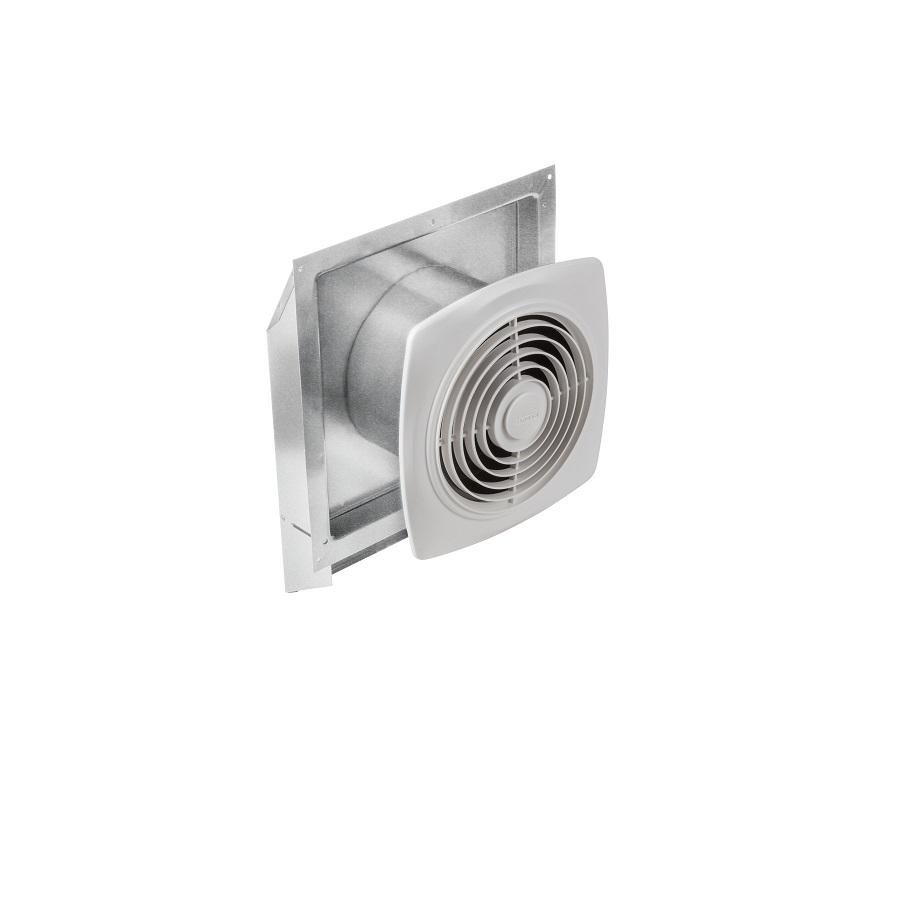
Common Mistakes and How to Avoid Them
When installing your bathroom exhaust fan, some common mistakes can happen. To ensure your installation runs smoothly, let’s look at these common errors and how to avoid them.
Choosing the Wrong Fan Size
Incorrect fan size can lead to poor air movement. Use the space’s square footage to pick the right size. A fan with a higher CFM rating is better for larger bathrooms.
Poor Location Selection
Placing the fan in the wrong spot can reduce effectiveness. For maximum efficiency, position it between the shower and toilet.
Inadequate Venting
Not venting the fan outside can cause mold and damp problems. Make the duct short and straight for the best air flow.
Ignoring Electrical Safety
Trying to do the electrical wiring yourself can be risky. If unsure, hire a professional to ensure safe connections.
Failing to Seal and Insulate
Forgot to seal or insulate around the fan? This can lead to leaks and energy loss. Use caulk and consider attic insulation.
Not Installing a Timer or Humidity Sensor
Not using timers or sensors can waste energy or miss moisture. These features help to run the fan just right.
By avoiding these common mistakes, your bathroom fan installation can keep your bathroom fresh and moisture-free. This protects your health and home from the dangers of dampness.
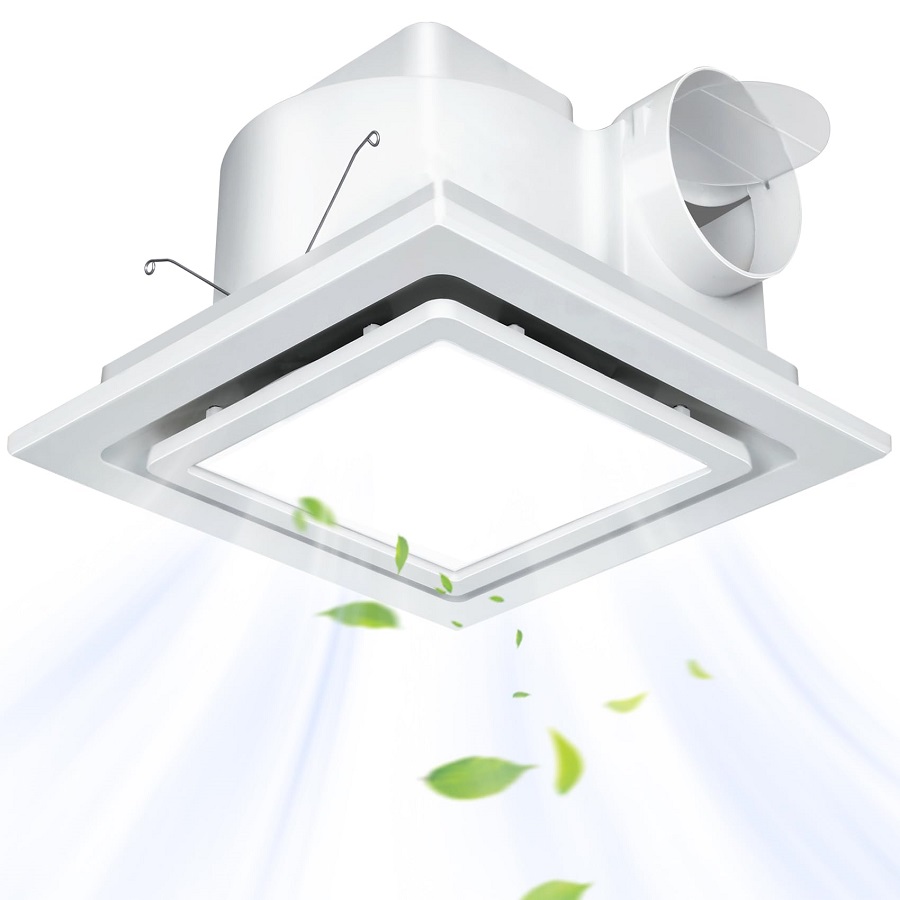
How to Determine the Right Fan Size and CFM for Your Bathroom
Selecting the right fan size and CFM is crucial for effective ventilation. A fan that’s too small won’t adequately remove moisture, while one that’s too large may waste energy. Here’s what you should consider to find the perfect fit for your bathroom.
- Measure Your Bathroom: Calculate the square footage by multiplying its length by width. This gives you the area size.
- Check Fan Recommendations: Manufacturers often suggest 1 CFM per square foot of bathroom area. Use this as a starting point.
- Consider Ceiling Height: For ceilings over 8 feet, choose a fan with a higher CFM to compensate for the extra space.
- Look at Bathroom Fixtures: Add 50 CFM for each standard fixture like a toilet or shower. For jetted tubs, add 100 CFM.
- Account for Duct Length: Long duct runs may require a fan with more power. The longer the duct, the higher CFM you’ll need.
- Be Mindful of Noise: Choose a fan with a low sone rating for quieter operation. You don’t want a noisy fan.
- Consider Special Features: If your fan has features like heaters, you might need additional CFM.
- Check Building Codes: Local regulations might specify minimum ventilation requirements. Make sure you comply.
By carefully considering these aspects, you will ensure your bathroom remains well-ventilated with fresh air, preventing excess moisture and mold growth, and preserving your bathroom’s comfort and longevity.
When to Consider Replacing an Existing Fan
Knowing when to replace a bathroom fan is key to maintaining a healthy environment. Look out for these signs to determine if it’s time for a new fan installation.
Loud or Unusual Noises
A fan that starts making noise, like rattling or humming, may be failing. This is a common issue with older fans.
Poor Ventilation
If the bathroom stays foggy after a shower, or if smells linger, the fan might not work effectively. This could mean it’s time for a replacement.
Visible Wear or Damage
Check for signs of rust, wear, or damage to the fan unit. Such issues can hinder the fan’s performance and require a new installation.
Fan Doesn’t Start Properly
A fan that struggles to start or doesn’t turn on at all might need replacing. This is often due to motor issues.
Outdated Model
Older fans may not be as efficient or have modern features. Considering a more recent model can save energy and reduce noise.
High Energy Bills
If your energy bills are increasing and the fan is the suspected cause, upgrading to an Energy Star-rated model may help lower costs.
By watching for these signs, you can decide the right time to replace your bathroom fan. A new fan can ensure better air quality and lower maintenance costs. If installing a new fan feels too complex, remember, you can always seek professional help.
